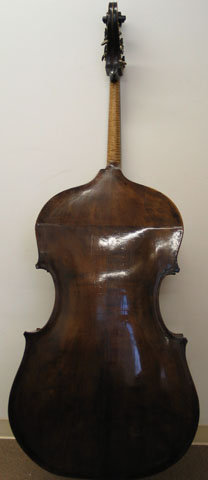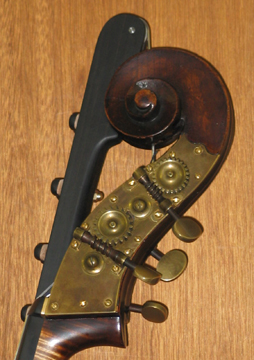
 |
|
|
|
#1
|
||||
|
||||
|
Thanks for the links. I am mainly interested in the Round Back models by 'old' Panormo, Vincenzo. I have never seen one that was Flatback and authentic. The Grossman Bass I think is a Lott, not a Panormo. The outer linings and other features look more Lott/Dodd style than anything else to me.
The Molitz/Gage bass is beautiful as is the one from Gallery. The Jack Hill(Filo/Martin) Bass is nice I assume but the pictures do not do it justice. I am sure it sounds great because I know who bought it and he's very picky. Those three look like the real deal. The 5-string Gagliano in the Elgar book is actually attributed to either George or Joseph Panormo. It is a 4-string now once again. I have here in my posession a Panormo (or School) Bass that had been re-varnished when it came in for sale and also needing a huge restoration. The Varnish was touched up a bit during the restoiration but still, not the same flavor of a real Panormo in the finish. The Scroll I think was left original thankfully. Hopefully I can get some good pictures up on my website soon and post it. This one is a 4/4 sized bass with a slight block cut getting the string length down to 42" with a newly grafted flamed maple Neck with D-heel. It looks like all the other 'real' Panormos but without any certification. The more I see the better. That's the only way to know how close a bass is to an original. |
|
#2
|
||||
|
||||
|
yes, please!
|
|
#3
|
||||
|
||||
|
Here are some pics of the Bass. I will take better ones in the future after the Extension is put on or before if we have the time.
    
__________________
Ken Smith ~ http://www.kensmithbasses.com http://www.kensmithbasses.com/doublebasses/ http://www.facebook.com/KenSmithBasses https://www.instagram.com/kensmithbasses/ https://www.facebook.com/ken.smith.904750 
Last edited by Ken Smith; 10-30-2009 at 08:00 AM. Reason: new pics taken |
|
#4
|
|||
|
|||
|
Quote:
|
|
#5
|
||||
|
||||
|
Quote:
I have it here beside me as I write this. As some of you know, I have been going back and forth with my personal basses trying to choose one as my own so I can work on my left hand accuracy. Switching basses every week does not help that one bit and in fact, hinders ones progress. This bass has what I would consider a world class restoration. Arnold restored it with the intention of bringing it to the ISB to show the world and the world did see this bass. Everyone I spoke with of note at the show played and/or looked over this bass from players to Luthiers. Given the date of the ISB as a fixed schedule the restoration had to be completed within a week of the show. Arnold didn't have the time to make a c-extension for it so it's only a 4-string for now. My Big Gamba went out for an Extension and some repairs as well and needed to be done on the same schedule. When the Gamba was done I drove straight to Arnold's shop from Jeff's place to show him the bass. We compared these two 'big boys' side by side and each played them both. The Panormo(?) bass and my big Gamba are completely different in design and tone. Both powerful and both earth shakers. I just had to have this one as to me, the response with the bow is amazing. I can also play it in tune and hit 'almost' all the notes above the Neck in TP. That's better than I do with most basses at first that are even smaller, regular sized instruments. I have a concert next week and one piece is the Flying Dutchman with two lower notes to start, DD/D#D# and then up chromatically to the upper d on the G-string. This excerpt is actually in the Simandl book but it's quite fast and played more like 16ths than 8ths as written. Guess what? I would rather tune the Panormo down to a low D than bring the Hart or Martini with the C-Extension. We also have a Piano Concerto to do by Ravel that has a few low Cs and Ds in but for the rest of the playing, even an octave up this bass will out perform the other extensions in my section for depth. I took this same attitude when I played the Storioni two years ago doing the Tchik./Romeo. My bass was deeper than the big German monster next to me at an octave lower on some parts. So guess what.. this one's personal. I am using this bass for Orchestra and leaving my Martini and Hart in the rack. To me, this bass sounds and feels more Italian than English, much more. Who knows, maybe it's a Betts shop bass by Panormo which wont always be the same as Panormo made on his own. He made what he was told with the woods supplied and had to complete it on a schedule. Instruments made this way are harder to identify and usually do not look like the makers personal work. This Bass is quite old as I have seen it inside and out from almost the day that Arnold got the bass. I watched it during restoration every time I visited and although I wished it found a good home thru Arnold, the economy is just not to speed just yet. I figured the bass needed a home and I had a space in my rack for it. Thank you Arnold one again for your attention to detail. This bass is beautiful. The only problem I will have playing is that the other players around me wont be as happy. Like bringing a Tank to a Gun fight.. lol |
|
#6
|
||||
|
||||
|
I have been reading thru my various collection of books and they all say the same more or less about Panormo. Some more and some less.
On one website they show the bass as made by 'Vincenzo Trusiano Panormo'. I thought at first that was just some fancy way or making it look better on line until I read more about him. One of the best descriptions I found on Panormo is in one of my oldest books which is by George Hart, the son of John Thomas H. whom I have a bass of his here as well. Here are some basics on Panormo. His name is NOT Panormo! The family name is actually Trusiano!! He came reportedly from Monreale near Palermo, Sicely but even that is unconfirmed in the records of Baptisims. Some books has his city misspelled as Montreale (with T added in error) which is near central Italy (actually spelled Montereale), not Sicely. The name Panormo as I have read in 'Javolec' is Italian for the Latin name Panormus, the name given to the whole region before the Punic wars (2nd century or so). At the time of the Hart book, they had not yet learned of his true family name or made mention of it in the text. Later I assume it was discovered that the name Panormo was some version the region he was from and had adopted as his name. Clever if you ask me. About him he does write this; "Vincenzo Panormo was the slave of many, manufacturing Double Basses and other instruments from the material selected and purchased by his temporary employer, ofttimes compelled to carry out some crotchet of the patron much against his own wishes. The wood thus forced upon him was often the worst description; and, in addition, he was frequently obliged to complete his work within a given time. Instruments manufactured under such conditions can scarcely, it may be supposed, add to the makers reputation. We cannot but regret that he should have been obliged to waste himself on such poor materials. Fortunately, however, in some cases he found time to exercise his skilful powers to their full extent, and has thus bequeathed to us some of the finest specimens of the copyist's art." George Hart, London 1884. Coming from Dublin via Paris, Panormo arrived at his final destination in London around 1791 where he found employment in the shop of John Betts. It may be in a shop like this that the reference above is made from. I have seen a few basses attributed to the Betts shop and one of them is 4/4 bass and is authentic and labeled. That bass may be slightly before Panormos arrival in London... |
|
#7
|
||||
|
||||
|
|
|
#8
|
||||
|
||||
|
Quote:
A lot of who worked for who is speculative to a degree because many of them worked in a shop for another and then either had their own shop or worked from home doing double duty. Also, some of the makers noted as 'workers' were actually never employed directly by or in the shop of but rather contracted to supply instruments as a subcontractor or 'out worker' as they also called it. Sometimes fully completed, sometimes 'in the white' and sometimes without the Scroll, just a carcass. I have seen one S.A.Forster Bass where the bass is 100% John Lott but not the Scroll or the Varnish. I read by the author that there were 5 of these made and from a living source that they are all the same model and make thus showing Lott was his bass carcass supplier. As claimed by T.Martin in the link above that this Dodd bass was made by Joseph is news to me as only Fendt and Lott Snr's. are recorded as having made their basses. Fendt though up until the time he left the shop to work for Betts.. maybe? maybe not. There is really no way to know 100% who made what for whom without having been there watching them work. It is only guess work putting the pieces together. Some puzzles more complete than other. For the record, I am mainly interested in finding pictures of Vincenzo's basses regardless of where they were made. I have heard of at least one made in Italy but do not recall seeing it. I have not heard of any made in Paris where he also worked and lived for a time or Dublin where he was briefly for about a year possible associated with Thomas Perry. |
|
#9
|
|||
|
|||
|
I won't exactly add any important information here, but as I've mentioned before, my old teacher has been over to Martin's place and tried the various basses. What was then attributed to Maggini is now attributed to da Salo, but the one he fancies is the Joseph Panormo. Apparently, both are extraordinary instruments, but the Panormo was just a bit more accessible. He'll go back and make up his mind in the end of this month, I believe. But now, there's also a Hieronymous Amati thrown into the picture... the plot thickens.
 Point being, that a good Panormo is most likely as good as it gets. |
 |
| Currently Active Users Viewing This Thread: 8 (0 members and 8 guests) | |
| Thread Tools | |
| Display Modes | |
|
|